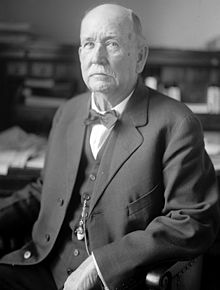Clement C. Dickinson
Clement Cabell Dickinson (born December 6, 1849 in Prince Edward County , Virginia , † January 14, 1938 in Clinton , Missouri ) was an American politician . Between 1910 and 1935 he represented the state of Missouri in the US House of Representatives several times .
Career
Clement Dickinson enjoyed a private school education. He then attended Hampden-Sydney College in Virginia until 1869 . From 1869 to 1872 he worked as a teacher in the states of Virginia and Kentucky . Since September 1872 he was in Clinton (Missouri), where he was initially active as a teacher. After a subsequent law degree and his admission as a lawyer in 1875, he began to practice there in his new profession. Between 1877 and 1882 he was a district attorney in Henry County ; from 1882 to 1884 he served as a municipal attorney in Clinton.
Politically, Dickinson was a member of the Democratic Party . From 1900 to 1902 he was a member of the Missouri House of Representatives ; from 1902 to 1906 he was a member of the State Senate . Between 1907 and 1913 he was a board member of the State Normal School in Warrensburg . After the death of MP David A. De Armond , Dickinson was elected as his successor to the US House of Representatives in Washington, DC , where he took up his new mandate on February 1, 1910. After five re-elections, he could remain in Congress until March 3, 1921 . The First World War and the ratification of the 16th , 17th , 18th and 19th amendments to the Constitution took place during this period . In 1920, Dickinson was not confirmed.
In the 1922 congressional elections , he was re-elected to the US House of Representatives in Washington in the sixth district of Missouri, where he succeeded Republican William O. Atkeson on March 4, 1923 , who had replaced him two years earlier. After two re-elections, he was able to spend three more legislative terms in Congress until March 3, 1929. In 1928 he was defeated by Republican Thomas Jefferson Halsey . In the elections of 1930 Dickinson was re-elected to the US House of Representatives, where he replaced Halsey on March 4, 1931. After re-election in 1932, he could remain in Congress until January 3, 1935. From 1933 he represented the seventh district of his state there as the successor to Robert Davis Johnson . In 1933 the 20th and 21st amendments were ratified. Since 1933, the first New Deal laws of the federal government were passed by Congress under President Franklin D. Roosevelt .
In 1934, Clement Dickinson was no longer nominated for re-election by his party. After leaving the US House of Representatives, he returned to work as a lawyer. He died in Clinton on January 14, 1938.
Web links
- Clement C. Dickinson in the Biographical Directory of the United States Congress (English)
| personal data | |
|---|---|
| SURNAME | Dickinson, Clement C. |
| ALTERNATIVE NAMES | Dickinson, Clement Cabell (full name) |
| BRIEF DESCRIPTION | American politician |
| DATE OF BIRTH | December 6, 1849 |
| PLACE OF BIRTH | Prince Edward County , Virginia |
| DATE OF DEATH | January 14, 1938 |
| Place of death | Clinton , Missouri |

